I’ve been reading an old accident investigation report from the National Transportation Safety Committee in Indonesia. You may recall the frightening photographs that hit the press in March 2007, when this Boeing 737 overran the runway at Yogyakarta and was destroyed from the impact and resulting fire. One flight attendant and twenty passengers were killed and twelve others were seriously injured.

Dozens of passengers leapt from the national carrier Garuda Airline plane's emergency exits into surrounding rice paddy fields to escape the inferno, which reduced the aircraft to a smoldering wreck of twisted metal. -Dwi Prasetyo on Reuters.com
The accident investigation report reference KNKT/07.06/07.02.35 is available online at the NTSC site as a PDF: Final Report.
Here’s my summary and analysis of the key information including excerpts from the Aircraft Accident Investigation Report by the NTSC. All images are from the report unless otherwise noted, in which case they link to the original source.
All times are given in UTC. Local time for Yogyakarta, Indonesia is UTC+7 hours.
On 7 March 2007, a Boeing Company 737-497 aircraft, registered PK-GZC, was being operated by Garuda Indonesia on an instrument flight rules (IFR), scheduled passenger service, as flight number GA200 from Soekarno-Hatta Airport, Jakarta to Adi Sucipto Airport, Yogyakarta. There were two pilots, five flight attendants, and 133 passengers on board.
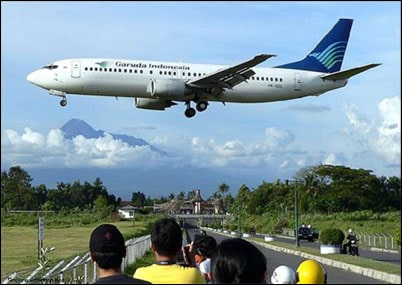
ATC referred to the flight as “Indonesia 200″.
Here’s the timeline of the events:
21:30 Pilot in Command (PIC) and co-pilot commence duty at Jakarta.
Both pilots had over a day of rest time before the flight. There’s no evidence that either was unfit for duty.
The PIC had logged 13,421 hours flight time with 3,703 as pilot in command on type. He completed Controlled Flight into Terrain and Approach-and-Landing Reduction training recurrency just over a year before the accident.
The copilot had logged 1,528 hours of which 1,353 were on type.
Both crew members had attended an introductory seminar for the Enhanced Ground Proximity Warning System in 2005.
However, the accident report notes that there is no evidence that either pilot had been checked or received Boeing 373 similator training for appropriate vital actions and responses for alerts as warnings, such as TOO LOW TERRAIN and WHOOP, WHOOP, PULL UP. Note that the correct response to such a warning is to take control of the aircraft and aggressively apply maximum thrust, get the wings level and pitch up to 20 degrees. This will be important later.
23:17 Indonesia 200 departs Jakarta.
PIC was the pilot flying with the copilot offering monitoring and support. The initial flight was uneventful.
Up to the time of the top of descent briefing, the oral communication between the PIC and the copilot, air traffic control approach and tower controllers, and the company radio, were in normal tones and in an orderly manner. Subsequently, during the approach below 10,000 feet and prior to reaching 4,000 feet, the PIC was singing and there was some minor non-essential conversation, which was not in accordance with the Garuda Basic Operations Manual policy for a sterile cockpit below 10,000 feet.
23:43 PIC begins the crew briefing. The briefing is interrupted by Yogya Approach with clearance. After the radio call, the PIC continued with the crew briefing for an ILS approach.
23:54:10 Pressure altitude 6,560 feet, airspeed 269 knots
Yogya Approach asks the crew to confirm that they are visual.
The copilot responds with ‘affirm’.
At no time did the copilot inform ATC that they were flying the 09 ILS approach.
The Approach Controller cleared Indonesia 200 “for visual approach runway zero nine, proceed to long final, report runway in sight.”
The copilot read back the clearance and asked if they were cleared to descend to circuit altitude.
23:54:33 Pressure altitude 5,792 feet, airspeed 279 knots
The Approach controller clears Indonesia 200 to descend to 2,500 feet.
During this descent the PIC commented “Oops, strong wind”, showing a lack of observation of the strong wind they’d encountered during the flight. The wind at this stage had decreased from previous levels as they descended.
Eleven seconds after expressing concern about the wind, the PIC said ‘Target enam koma enam ILS, kagak dapat dong’ (the target is 6 point 6 ILS, we will not reach it). The PIC then attempted to trade off excess airspeed and lose height, but only succeeded in flying a flight path that was erratic in pitch, causing the airspeed and altitude to vary considerably. The PIC flew an unstabilized approach.
23:55:19 Pressure altitude 4,384 feet, airspeed 293 knots
The aircraft at this stage is at 3,419 feet above aerodrome elevation and flying much too fast.
The Garuda Aircraft Operation’s Manual specifies a maximum control speed in the terminal area below 10,000 feet as 250 knots. A speed over 250 knots requires air traffic control approval.
The airspeed increased from 288 knots to 293 knots then reduced to 243 knots.
Effectively, the PIC went into a steep descent to trade height for speed at a point in the approach when he should be losing height and speed. He lost 2,912 feet with his erratic flight path.
23:55:33 Aircraft is 10 miles out. Initial fix in the approach chart is 2,500. Aircraft was 1,427 feet above this and travelling at 283 knots.
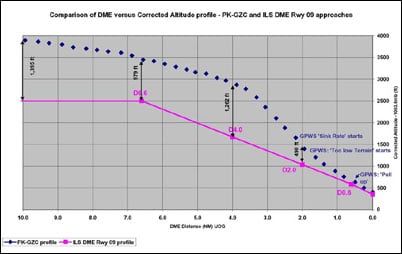
The company Operations Manual required the aircraft to be configured for the landing, with the landing gear extended, flaps 15, and the airspeed 150 knots, when approaching the final approach point (FAP), one dot up on the glideslope instrument. When GA200 passed the FAP, the speed was 254 knots (groundspeed 286 knots), and it was in the clean configuration, meaning that the landing gear and flaps were not extended.
This is twenty seconds after he’d stated that they won’t reach the target.
23:56:35 Pressure altitude 3,456 feet, airspeed 239.5 knots
Wing flaps 1 degree position set.
Yogyakarta Tower: Surface wind calm, continue approach runway 09 report final
Runway 09 has a landing distance of 2,200 metres.
23:56:46 Pressure altitude 3,296 feet, speed 231 knots
PIC: gear down
They are now 2,596 feet above aerodrome elevation.
The gears are extended. The plane continues to descend. It is too high and too fast.
23:56:49 PIC: oh there is something not right
Between 23:56:49 and 23:57:20 the aircraft was in an unstabilized approach condition with the speed varying between 229 and 244 knots, pitch varying between 3.5 degrees up and 3.8 degrees down, and the rate of descent reached 3,520 feet per minute at 23:57:20.
[...]
The PIC said ‘The target is 6.6 ILS, we will not reach it’. The PIC flew an unstabilized approach. He also realized the abnormal situation when he commented ‘Wah, nggak beres nih!’ (‘Oh, there is something not right’). So, the PIC’s intention to continue to land the aircraft, from an excessively high and fast approach, was a sign that his attention was channelized during a stressful time.
23:57:13 PIC: check speed, flaps fifteen
23:57:15 Ground Proximity Warning System: SINK RATE SINK RATE
The terrain closure rate is 3,461 feet per minute. The aircraft is 1,369 feet above the runway.
23:57:17 Copilot: flaps five
The PIC requested fifteen as well as a speed check. The copilot did not offer a speed check nor did he make any attempt to explain why he intended to set the flaps to five instead of fifteen.
The reason was clear. The recorded airspeed of the aircraft at that point was was 238 knots. The maximum indicated airspeed for extension of flaps to the 15 position is 205 knots. So why didn’t he say so?
At interview the copilot stated that he did not extend the flaps to 15 degrees as instructed by the PIC, because the airspeed exceeded the maximum operating speed for flaps 15.
The PIC stated that he was unaware of the actual airspeed, and expected that the copilot would inform him of any speed concerns.
Quite right! On the other hand, he’s already ignored the Ground Proximity Warning System and he did not react to any of the other statements by the co-pilot, so it may not have made a difference. Still, there’s a critical failure here in terms of monitoring and support.
23:57:19 Tower Controller: Indonesia 200, wind calm, check gear down and lock clear to land runway 09
Ground Proximity Warning System: TOO LOW TERRAIN TOO LOW TERRAIN
23:57:23 The copilot selects wing flaps to the five degree position.
PIC: Clear to land Indonesia 200
Remember that as far as the tower controller is aware, they are doing a visual approach.
23:57:29 PIC: Check speed, flaps fifteen
PIC: Flaps fifteen
PIC: Flap fifteen
PIC: Check speed, flap fifteen
Their speed was around 252 knots at the first of these four times the PIC requested flaps fifteen. Maximum flaps operating speed for Flaps 5 is 250 knots. Flaps 15 maximum is 205 knots.
During this time, and until 1 second before the GPWS sounded ‘ten’, meaning 10 feet above the runway, the GPWS warning continued to sound loudly.
At interview, the PIC stated that he continued to call for flap fifteen because he was committed to land from the approach, and was aware that he would not be able to use flaps 40 as planned. He knew the risks, but believed that he could safely land using flaps 15, even with the higher airspeed required for a flap 15 approach.
23:57:34 Flaps reach the five degrees position
The aircraft is 569 feet above the runway. Airspeed is 254 knots, rate of descent is 1,600 feet per minute.
Garuda Indonesia Operations Manual states that any approach that becomes unstabilised below 500 feet above the aerodrome in VMC requires an immediate go around. The aircraft had never achieved a stabilised approach.
23:57:37 PIC: flight attendant, landing position
This was seventeen seconds before touchdown. The flight attendants should have been given enough time to sit and fasten their seat belts and “sit quietly for one minute to recall the emergency memory items.”
23:57:41 Ground Proximity Warning System: WHOOP, WHOOP, PULL UP
You’ll remember the correct response to this warning is to aggressively apply maximum thrust. That is, go around.
23:57:43 Copilot: Wah Captain, go around Captain
The aircraft is 217 feet above the runway. I don’t know about you but I was shouting “Go around!” at my screen long before this point.
23:57:45 Ground Proximity Warning System: WHOOP, WHOOP, PULL UP
There’s no justifiable reason not to go around at this point. This is pretty much the definition of an unstabilised approach. Almost every factor is wrong.
The copilot should have taken control and initiated a go around as the PIC hadn’t.
The PIC response to the situation is telling.
23:57:47 PIC: Landing checklist completed, right?
The PIC does not appear to have registered the warnings nor the copilot’s call to go around at all. The accident report describes his actions as fixated.
He intended to land the aircraft, so that the other tasks and warnings (GPWS ‘PULL UP’ and calls from the copilot) were either not heard or were disregarded. His attention was channelized and focused on landing the aircraft from the approach.
That is to say, his every priority was the landing and he simply disregarded all information that was not directly relevant to landing the plane. He never considered aborting the landing, so information relevant to not landing the plane was disregarded.
The copilot made no attempt to take control of the aircraft from the PIC.
Seven seconds before touchdown, the rate of descent was 1,400 feet per minute and decreasing. The aircraft crossed the runway 09 threshold at 89 feet above the ground (704 feet pressure altitude), at an airspeed of 234 knots (groundspeed of 236 knots).
The aircraft is travelling 98 knots too fast as it crosses the threshold.
The aircraft levelled off about ten feet above the runway for 4 seconds before touching down with a groundspeed of 235 knots.
The touchdown should have occurred around 300 metres from the landing threshold. The touchdown zone ends at 620 metres.
23:57:54 The aircraft touches down for the first time, 860 metres from the threshold, airspeed 221 knots.
The landing speed for 40 degrees flap is 134 knots. The maximum tyre speed is 195 knots groundspeed.
The plane’s touchdown speed was 221 knots. It landed 240 metres past the touchdown zone.
23:57:54 Copilot: go around
The aircraft bounces. Twice.
At the third (final) touchdown, the nose landing gear touches down heavily before the main landing gear.
The g force at the third (final) touchdown was about 2.9 g, and the aircraft’s pitch angle was about -1 degree (nose down), which caused the nose landing gear to touchdown heavily before the main landing gear. The left nose wheel tire failed due to high rotational forces applied during the initial landing roll. The subsequent bending load on the left nose wheel axle was above the material’s ultimate strength and caused the left axle to fail. Metal from the failed left nose wheel slashed the right nose wheel tire, causing deep cuts to the tire’s crown. The outer hub of the right nose wheel separated, leaving pieces on the runway. The inboard hub of the right nose wheel remained attached to the right axle and was scoring the runway during the high speed landing roll.
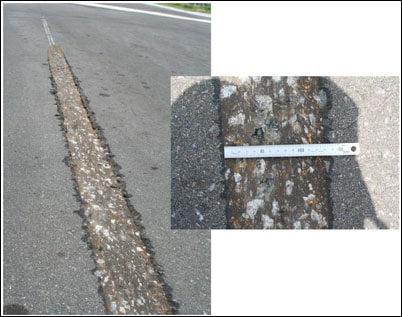
I have to give the PIC credit, that’s perfectly lined up on the centre-line, even after two bounces!
23:58:10 The aircraft overran the departure end of runway 09 at Yogyakarta Airport.
The Runway End Safety Area (RESA) is a paved area of 60 metres long. There is an additional 98 metres of grass thereafter which is not defined as part of the RESA. The ICAO standard requires a distance of at least 90 metres and recommends a RESA of 240 metres or more for a Category 3 airport such as Yogyakarta.
The PIC reported that as the aircraft was about to leave the runway, he shut down both engines. The aircraft crossed a road, and impacted an embankment before stopping in a rice paddy field 252 meters from the threshold of runway 27 (departure end of runway 09).
The fire fighting personnel noted the fast and high approach of the aircraft and the burst wheel on the runway. They mobilised two fire fighting vehicles to the perimeter fence immediately. But they couldn’t get past the embankment that the aircraft had barrelled through.
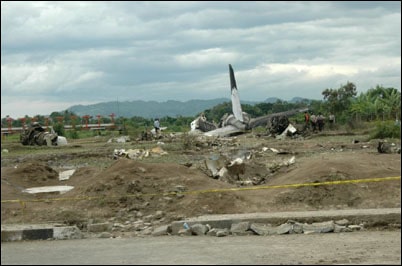
The fire fighters were unable to reach the wreckage due to the embankment and remained in position about 130 metres from the centre of the crash site. They sprayed the foam fire suppressant from the embankment but it was too far for the spray gun to reach. They attempted to deploy the flexible hose but it was punctured by vehicles driving over it and on the airport fencing. As a result of the lack of pressure, they were not able to cover the whole surface of the wreckage.
The fire was uncontrolled and consumed the aircraft.
The Airport Emergency Plan (AEP) required, the chief of fire fighting AP1 to lead the fire fighting operation, but at the time of the accident he was not able to lead the operation, due to too many people trying to act as leader and giving commands to fire fighting personnel. About 45 minutes after the accident, two city fire fighting vehicles arrived and were ordered by an un-qualified person to start hosing the fire. However, the city vehicles did not have foam; only water.
02:10 The fire is finally extinguished. The rescue operation continues.
Human factors are always an issue in any emergency situation and must be taken into account. But this Garuda Indonesia accident was so beset by problems, it is off the charts.
The co-pilot appears to have completely failed to offer basic monitoring and support to the pilot. He did not appear to notice the wind, he did not warn the PIC of excessive speed, he chose not to fulfil the PIC’s instructions but did not tell the PIC, and he did not respond at all to the repeated requests for a speed check. Once it was clear that the PIC planned to continue the landing from an unstabilised approach, he should have taken control of the aircraft and gone around.
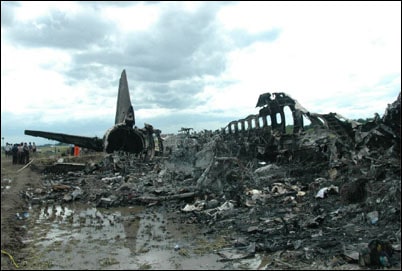
The chaos of the rescue operations encompasses a further few pages of the report, which I have not covered in detail here. It took over two hours to extinguish the fire and although the report is not clear on the effects of this, it does say that this delay “may have significantly reduced survivability”.
But all of this pales into insignificance in the face of the pilot who continued the approach and landing despite all evidence available to him that this was an unsafe landing.
Garuda Indonesia’s policy is very clear: in case of an unstabilised approach, go around. Let’s see how many of the elements of a stabilised approach were in place?
Garuda Stabilised Approach Procedure
Recommended Elements of a Stabilized Approach
All approaches should be stabilized by 1000 feet HAA in instrument meteorological condition (IMC) and by 500 feet HAA in visual meteorological conditions (VMC). An approach is considered stabilized when all of the following criteria are met:
- the aircraft is on the correct flight path.
- only small changes in heading/pitch are required to maintain the correct flight path.
- the aircraft speed is not more than VREF +20 knots indicated airspeed and not less than VREF.
- the aircraft is in the correct landing configuration.
- sink rate is no greater than 1,000 fpm; if an approach require a sink rate greater than 1,000 fpm, a special briefing should be conducted.
- power setting is appropriate for the aircraft configuration.
- all briefing and checklist have been conducted.
These conditions should be maintained throughout the rest of the approach
for it to be considered a stabilized approach. If the above criteria cannot be
established and maintained at and below 500 HAA, initiate a go-around.
The PIC did not reduce the aircraft’s speed to the target airspeed of 141 knots for the approach. The actual speed was 245 knots. The aircraft was not in the landing configuration, and the actual sink rate of 3,520 fpm exceeded the Operations Manual requirement of not greater than 1,000 fpm. The landing checklist was not completed.
In fact, I’d say that out of the seven criteria, the approach might have fulfilled one: I presume the power setting was appropriate.
As the aircraft crosses the runway threshold it should be:
- Stabilized on target airspeed to within +10 knots until arresting the rate of flare.
- On a stabilized flight path using normal maneuvering.
- Positioned to make a normal landing in the touchdown zone (i.e., first 3,000 feet or first third of the runway, whichever is the less).
Initiate a go-around if the above criteria cannot be maintained.
Not any of these were in place.
The investigators asked the PIC what happened.
During interview he said to investigator that ‘his goal was to reach the runway and to avoid severe damage’. He ‘heard, but did not listen to the other voice (GPWS), and flaps 15 and speed 205 was enough to land’. The PIC experienced a heightened sense of urgency, and was motivated to escape from what he perceived to be a looming catastrophe, being too high to reach the runway (09 threshold). He fixated on an escape route, ‘which seem most obvious’, aiming to get the aircraft on the ground by making a steep descent. His decision was flawed, and in choosing the landing option rather than the go around, fixated on a dangerous option.
The NTSC Aircraft Accident Investigation Report concludes with the following primary causes:
- Flight crew communication and coordination was less than effective after the aircraft passed 2,336 feet on descent after flap 1 was selected. Therefore the safety of the flight was compromized.
- The PIC flew the aircraft at an excessively high airspeed and steep descent during the approach. The crew did not abort the approach when stabilized approach criteria were not met.
- The pilot in command did not act on the 15 GPWS alerts and warnings, and the two calls from the copilot to go around.
- The copilot did not follow company instructions and take control of the aircraft from the pilot in command when he saw that the pilot in command repeatedly ignored warnings to go around.
- Garuda did not provide simulator training for its Boeing 737 flight crews covering vital actions and required responses to GPWS and EGPWS alerts and warnings such as ‘TOO LOW TERRAIN’ and ‘WHOOP, WHOOP PULL UP’.
For full details, read the final report from the NTSC.

No comments:
Post a Comment